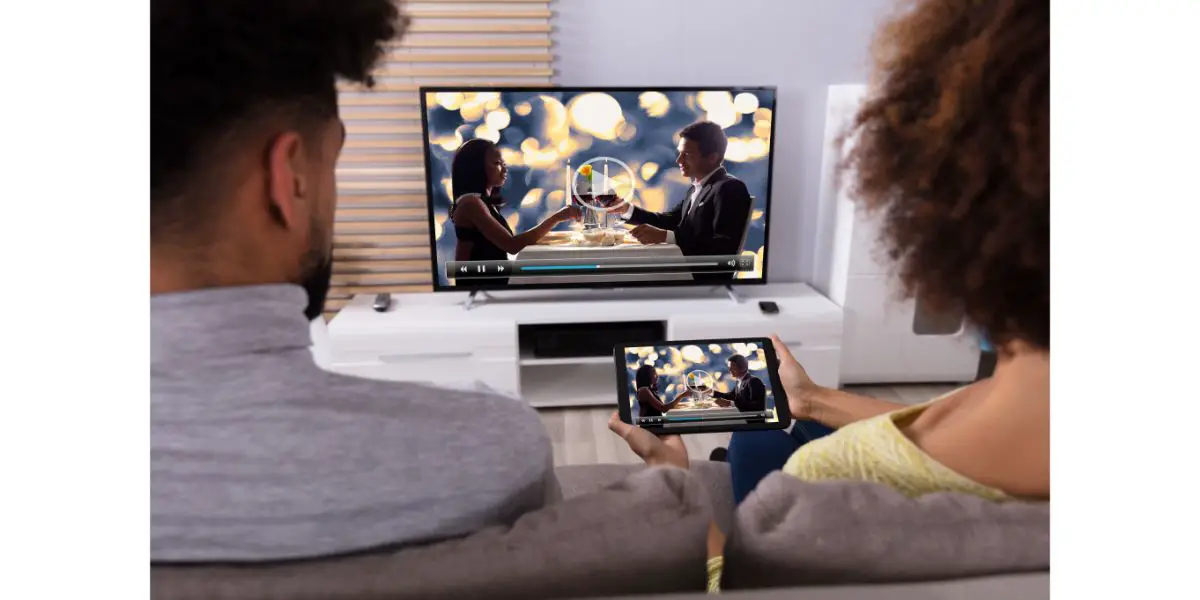Disclaimer: This post may contain affiliate links, meaning we get a small commission if you make a purchase through our links, at no cost to you. For more information, please visit our Disclaimer Page.
While it’s not quite the best way to bring your mobile games to the big screen, screen mirroring is a fantastic way to stream on a larger TV without the hassle of hooking up even more devices. Unfortunately, as cool as the technology can be at times, it doesn’t always work out perfectly.
If you’re getting audio and no video, the odds are good you’re dealing with compatibility, detection issues, wireless internet strength, Bluetooth interference, restrictions, or you just need to dump what you’re using and go with a 3rd-party option.
Sure, that sounds like a lot but, you’re probably only dealing with one of the above-listed factors. It pays to be optimistic about these things and work your way through the troubleshooting tips we’ve put together just for this topic.
Table of Contents
5 Causes And Fixes Screen Mirroring Sound But No Picture
1. Compatibility Issues
Just because the TV shows an option for screen mirroring doesn’t mean it’s entirely compatible with every smartphone or tablet out there. For instance, if you don’t see AirPlay but you see the screen mirroring option, it’s probably geared more toward Android devices than iPhones.
Samsung has Smart View, LG has Smart Share, and Apple has AirPlay. Of course, there are a lot more manufacturers than just those three. However, Apple, Samsung, and LG make up the vast majority of smartphone brands on the market today.
For obvious reasons, an LG TV will match up with LG’s Smart Share screen mirror app far better than it will with Apple’s AirPlay or Samsung’s Smart View. So, if you’re using a Samsung Galaxy S23 on your LG TV, therein lies the problem (at least in most circumstances).
AirPlay is a different animal entirely, especially since Apple is not a name in the TV manufacturing field. Large Macs and Macbooks will have no problem mirroring your iPad or iPhone.
However, a Samsung or LG TV may not deal with Apple AirPlay as well.
Just be sure to check over your TV model and manufacturer to see what it’s compatible with.
2. Interference with Bluetooth
When you have a bunch of devices using Bluetooth and you’re also using WiFi, things can get a little funny in terms of signal. If humans could suddenly see all of these signals, we would probably spend most of our time hiding under the bed.
The number of signals running through our bodies on any given day is staggering. Now, imagine all of those same signals bombarding your TV and smartphone, with more signals coming from each device respectively.
The thing is, you don’t need Bluetooth on to mirror your smartphone to the TV. Bluetooth is more than capable of interfering with WiFi; you just don’t need any of that action right now. So, how to deal with it?
Simple enough—turn off your Bluetooth. Turn it off on the TV and on your smartphone. If you have a bunch of wireless Bluetooth headphones sitting in the same room, charging on a magnetic charger, disconnect those as well.
The massive reduction in Bluetooth signals flying around all over the place, not connecting to anything, may be what’s causing audio-only communication between the smartphone and TV.
Maybe you don’t have a bunch of Bluetooth devices around, however, sometimes all it takes is one.
3. Restrictions
Just because your smartphone has screen mirroring or AirPlay on it, doesn’t mean it’s turned on. In fact, it’s probably turned off by default.
It’s a simple enough thing to turn it back on, whether you’re using an iOS or an Android device. The TV is different since there are so many brands out there.
There’s no way of telling whether your TV has the feature off or if it even has an ‘off’ option for screen mirroring.
That’s something you will have to figure out on your own. If we tried to walk you through turning screen mirroring on with your TV, we would have to write a novel and include hundreds of TVs.
On the bright side, we can walk you through turning it on with your iOS or Android.
iOS
- Open your Settings app on your iPhone/iPad
- Select ‘General’
- Select ‘AirPlay & Handoff’
- Toggle off ‘Transfer to HomePod’
- Select ‘Automatically AirPlay to TVs’
- Select either ‘Ask’ or ‘Automatic’
Android
- Open up the Settings menu
- Select ‘Display’
- Select ‘Cast Screen’
- Select the three, vertical dots in the upper, right-hand corner
- Check the box for ‘Enable Wireless Display’
Once you enable the features on either device, TVs that are actively attempting to communicate will show up as viable options to screencast to.
4. Use a Third-Party App
If your smartphone simply won’t cast both the audio and the video, again, it’s probably an issue of the compatibility being off. The TV may locate, display, and communicate with your smartphone (and vice versa), but that doesn’t mean that it’s the perfect, symbiotic relationship.
Third-party apps are often the better option, especially if you’re dealing with something like a Samsung TV and an LG smartphone or the other way around. Third-party options are often developed for a wide range of TVs, regardless of manufacturer.
This also works great when you bring in an outside device, such as a Roku stick, Firestick, or Google Chromecast. Oftentimes, third-party apps will simply work better with these devices than the smartphone will with your TV.
It’s worth considering, especially since these devices are very affordable. If you just prefer to stick with your TV’s mirroring capabilities, however, downloading a third-party app might work much better than sticking with stock. Worst case scenario: it doesn’t work and you can simply delete the app.
5. Internet Connection
Since both the smartphone and the TV depend on your WiFi’s strength, both can be affected by it in real-time. It’s no secret that audio files transfer much faster than video since video is often much larger.
Your WiFi signal strength may be so weak that all you’re essentially pulling is the audio and the video is way behind or not working at all.
Checking your TV to get an idea of the WiFi strength is on you since we don’t know what kind of TV you’re rocking.
It’s fairly simple to check WiFi strength on an iOS device or an Android. Not all Android smartphones are exactly alike, depending on the manufacturer but you can generally check your WIFi strength through the Settings menu.
- Open the Settings menu
- Select ‘About Phone’
- Select ‘Status’
- Select ‘Signal Strength’
There are a ton of Android apps out there for checking WiFi signal strength as well, so you have your choice of options. An iPhone is very simple. When it comes to WiFi, you can see the symbol for it in the top, right-hand corner of the screen.
If it has three, upward curving bars, you have a solid WiFi signal. If it has only two, your WiFi signal is moderate. One bar means it’s pretty weak and no bars means you’re about to switch over to your cellular network because WiFi is out of range.
If you want your exact up and down numbers, you’ll find plenty of WiFi signal strength apps on the Apple store as well.
Final Thoughts
Screen mirroring involves several things going on at once, with two separate devices communicating with a router and each other at the same time. The more complicated something is, the more likely it is to have issues.
It’s best to always make sure that both the TV and the smartphone have a strong signal. If nothing else, you can always download a third-party option as well.


